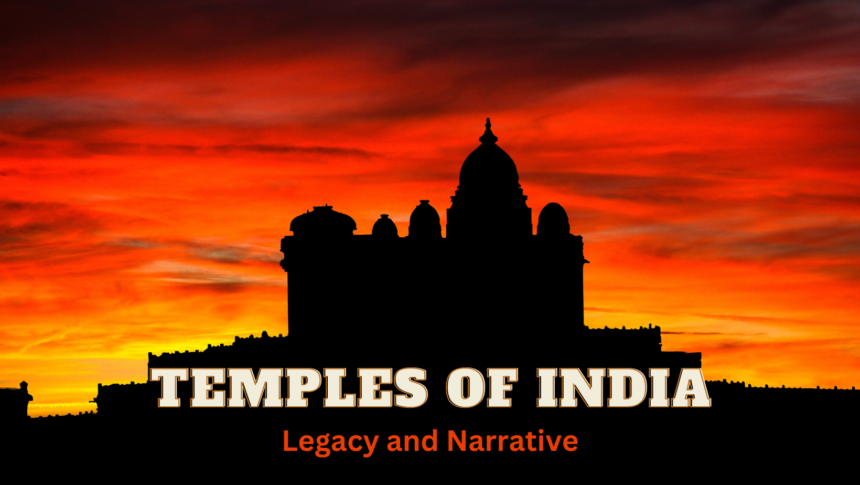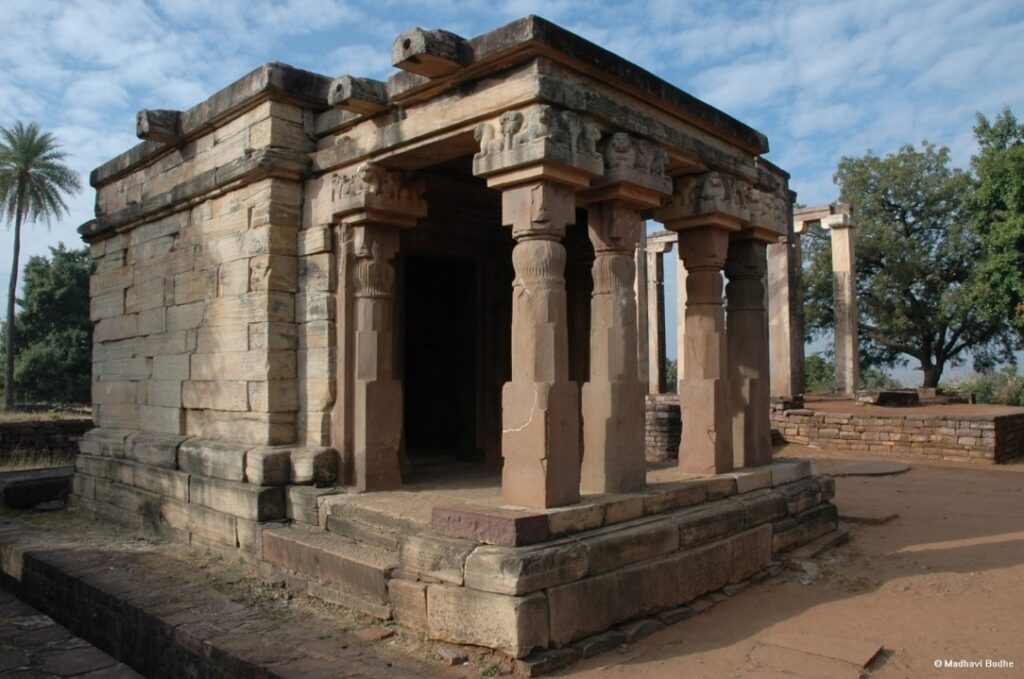Building a separate structure to house murtis, carriers of divinity, for personal and public worship of deities is an old tradition prevalent in India.
Manisha Chitale takes us through the history and evolution of temple architecture in the country and how temples have shaped the Sanatana dharmik civilisation.
Unseen Temples of India – Legacy and Narrative – Part 1

Sanchi in Madhya Pradesh has an important landmark, printed on our currency notes. The Buddhist stupa of Sanchi stands atop a modest hill. This monument is dated to the third century BCE and is built by Mauryan king Ashoka and enhanced by Shunga rulers thereafter. The same hill has several other building structures. And one of them is the predecessor to the long tradition of temple building – a tradition that spanned across the subcontinent geographically as well as chronologically.

The earliest temple standing today is Sanchi monument 17, a simple structure with pillars and a flat roof. As per experts, this is the earliest form of Indian Temple architecture in the illustrious tradition, and one of the first to dot this land. Similar early temples are found in the vicinity, Nachana Kuthara, and Bhumra, in MP, and Deogarh in UP, are some examples of early temple building styles.
The simplistic nature of these early temples stands out when compared to the majestic Brihadishwar temple of Tanjore or the ornate Khajuraho group of temples.
The experts have placed these early temples in the fifth century CE and assumed, that they were built in the Gupta era [R1]. Gupta kings ruled over a large territory in ancient India from their capital in Pataliputra and were followers of the Vedic religion.
We do see several carved caves in Sahyadri, Vindhya, and other mountain ranges which are dated as early as the Second century BCE, e.g the Bhaje caves. However, structural temples are free-standing; constructed, not carved, and not monolithic. Architecturally, a structural temple construction can be assumed to be the next level after monolithic cave carvings.
The Gupta era temples, ‘the first temples’ found primarily in central India are dated between the Fifth and Seventh century CE. Does this mean that the Indians started murti pooja during that time? Does this mean that this was the beginning of the creation of a place for worship, for social and public purposes?
Murtis are the symbols of divinity. They are depicted in human forms, characterising the deity they represent. Murtis can be temporary. They are created for a specific purpose and some of them are dissolved or submerged after the purpose or ritual is over. Such murtis could be primitive, and perishable. The earliest textual references for murtis can be found in Rigveda, the oldest scripture of India.
“Will someone buy my Indra” a man asks in one of the Suktas. Scholars think that ‘Indra’ here refers to either murti or a symbol of the deity and indicates a practice where a murti can be purchased.[R2]
There could be a tradition by which murtis of clay or wood were created, installed, prayed to, and later released back to nature, similar to the Ganpati festival and its rituals prevalent even today. Mauryan era (300-200 BCE) has several excavated artefacts which are labelled as mother figures, and earthen murtis, probably created for a similar purpose.
Murtis can be permanent too. They could be installed, they would be more elaborate, more ornate, and made from material such as stone or metal for durability. Such murtis could find a place permanently in homes or public places.
The Archaeological Survey of India has discovered several murtis which represent the antiquity of the Indian civilization. Sindhu-Saraswati valley cultures (Harappa Civilization) have come up with several figurines and shapes similar to the Shivalinga. Excavations of later periods such as at Mathura have continued discovering murtis of Buddha, Mahaveer, Vishnu, and Durga. A very recent excavation has uncovered the largest Bhu-Varaha sculpture depicting an avatar of Vishnu, on the face of a hill, along with several temples in the grassy Ranthambore forest.[R3]
The purpose of such murtis cannot be determined by archelogy alone, but it has to be discovered and interpreted through proper reading of scriptures, old texts, folklore, and ongoing traditions in practice.
Text references of Deities
Vedic literature right from Rigveda and Atharvaveda is replete with references to deities and their worship.
Ashtadhyayi is a text by Panini, one of the celebrated Sanskrit grammarians. Ashtadhyayi, mentions the worship of ‘arcas’ (अर्च पूजायाम्) implying murtis, along with mentions of Rudra and Vasudeva.[R4] Sage Panini is dated in 500 BC by mainstream historians.
Such permanent murtis must have given rise to the concept of temples. A permanent home for murtis to be worshipped, a common public place for all devotees to come together. A place that resonates with the nature of the murtis, a location that can impart sacredness to the premises.
Textual references for temples
Whether it be a confluence of rivers, the edge of a seashore, a mountain peak, or a perfect meditative spot in the middle of a jungle; the presence of the divine enshrined within a temple can be found.
Temples are abodes of deities, higher beings but still among us. Hence, it is not surprising to find temples on the busy banks of rivers, leading up the steps from the flowing water, and a town settles around it. Temples were pre-planned too, sometimes as a mark of new beginnings, in a newly built fort, or in a new settlement to bless the people and the surroundings.
Going back in time, we find several references about temples and deities residing in them in our ancient texts available to us. Apart from Vedic texts, Mahabharata, Ramayana, and Puranas along with several other texts mention a flourishing temple tradition of their time.[R5]
- Patanjali who wrote the ‘Mahabhashya’, a commentary on Panini’s work, extensively describes temples of Kuber, Rama, and Kesava as reverberating with dance, music, and rituals. Patanjali is dated in the second century BC.
- Arthshastra by Kautilya has reference to temples to be administered implying that building temples and maintaining them has already been a tradition. Kautilya’s Arthashastra from the 4th Century BC describes a city of temples, each enshrining various Vedic and Puranic deities. Kautilya also suggests punishments for thieves stealing deities or donations given to them.
- Valmiki Ramayana mentions temples in Koshala adorned with music playing on special occasions. Valmiki Ramayana is supposed to have been compiled between 200 BCE and 200 CE.
- Gatha Saptashati by King Hal Satwavahan is a collection of poems composed around the start of the first millennium. These simple and lyrical poems mention temples as ‘Deul’ or ‘Devalay’. The temples in Gatha provide shelter to travellers. They are sometimes outside the village and one gatha mentions a ruined temple too.[R6]
- The trio of ancient architectural mega texts comprising ‘Mansar’, Maymat’, and ‘Samrangan Sutradhar’ discuss different types of temples along with other topics. As per these texts a ‘Rajdhani’, should have a Vishnu temple in the west of the city and a Shiva temple to the northeast ‘Ishanya’ of the city. All these texts are supposed to be created over a long period of time ranging from the first century to the seventh century CE.
- Rajtarangini, the famous historical account of Kashmir mentions that Ashoka’s son Jallok built a temple in Srinagar, Kashmir. Ashoka’s reign is dated around the third century BC.[R7]
- The seventh century Chinese pilgrim Huen Tsang reports visiting several places and mentions temples, sometimes in hundreds at various places from Kashmir to Kanyakumari on his pilgrim path throughout India.[R8]
- Several current temple sites in India have undergone reconstruction and rebuilding on the same site and boast history going back thousands of years. This is primarily to preserve the location sanctity for the deity which is installed at a particular location. Arunachaleshwar temple at Thiruvannamalai representing the Fire element is mentioned in ancient Tamil works of scholars such as Nakkirar (1st century BCE to 1st century CE), Kapilar, and Paranar (125 to 225 CE). The current structure of the temple is attributed to the Chola period.
All these scriptural records strongly back the tradition of temples in the Indian subcontinent.
As per mainstream dating of various texts, the earliest references clearly come from 400 BCE, to say the least.
References:
[R2] Rigveda
[ R3] https://www.hindustantimes.com/cities/bhopal-news/asi-explores-100-archeological-remains-in-mp-s-bandhavgarh-tiger-reserve-101664375767491.html
[R4] Ashtadhyayi -Panini https://ashtadhyayi.com/dhatu/01.0232
[ R5] https://en.wikipedia.org/wiki/Hindu_temple
[ R6 ] Gatha Saptashati
[ R7 ] Rajtarangini by Kalhana – https://archive.org/stream/RajataranginiOfKalhana-English-JogeshChunderDuttVolumes12/Rajatarangini-JogeshChunderDuttVol2_djvu.txt
[ R8 ] Si-Yu-Ki https://ia801607.us.archive.org/1/items/siyukibuddhistre01hsuoft/siyukibuddhistre01hsuoft_bw.pdf

Leave a Reply